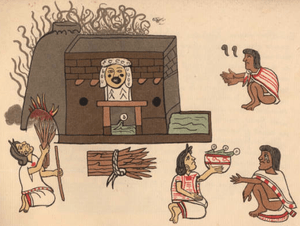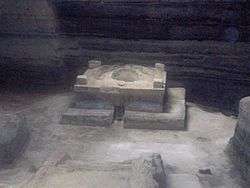Temazcal


A temazcal ([temasˈkal]) is a type of sweat lodge which originated with pre-Hispanic Indigenous peoples in Mesoamerica. The word temazcal comes from the Nahuatl word temāzcalli [temaːsˈkalːi] ("house of heat"), or possibly from the Aztec teme (to bathe) and calli (house).[1] Temazcal in English is also written as temezcal, temascal, or temescal.
In ancient Mesoamerica it was used as part of a curative ceremony thought to purify the body after exertion such as after a battle or a ceremonial ball game. It was also used for healing the sick, improving health, and for women to give birth. It continues to be used today in Indigenous cultures of Mexico and Central America that were part of the ancient Mesoamerican region for spiritual and health reasons. It is currently being recovered by all sectors of society in Mexico and Central America and is used as a cleansing of mind, body and spirit.
The temazcal is usually a permanent structure, unlike sweat lodges in other regions. It is usually constructed from volcanic rock and cement and is usually a circular dome, although rectangular ones have been found at certain archeological sites and this shape is also used. To produce the heat, volcanic stones are heated. Volcanic stones are safe because they do not explode from the temperature. They are then placed in a pit located in the center or near a wall of the temazcal.
See also
Notes
- ↑ Aaland, Mikkel. "Origin of the Temescal". http://www.cyberbohemia.com/Pages/originoftem.htm
External links
| Wikimedia Commons has media related to Temazcal. |
- Article on Temazcal (in English)
- Article on Oaxacan Temazcal
- Article on the use of the temazcal among the Tzeltal-Tzotzil Maya of Chiapas, Mexico